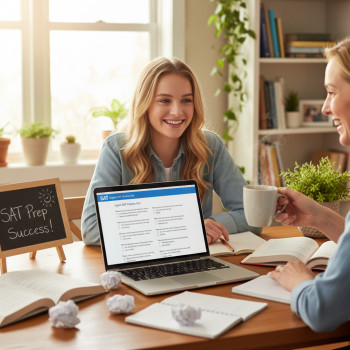Why Daily Reflection Matters More Than You Think
Imagine finishing a practice section and, instead of immediately moving on, taking five minutes to jot down what went well, what tripped you up, and what you’ll try next time. Small? Yes. Powerful? Absolutely. Daily reflection is the habit that turns repetitive practice into meaningful improvement. For the Digital SAT—where strategy, timing, and adaptability matter—reflection helps you notice patterns, internalize techniques, and build confidence without burning out.
Reflection is not journaling for journaling’s sake. It’s a targeted, tiny ritual that creates feedback loops. Over weeks, those loops compound; small course corrections lead to big score gains. If you’ve ever felt like you’re studying hard but not seeing results, reflection might be the missing link.
What reflection does for SAT prep
- Reinforces learning by turning mistakes into specific action items.
- Helps manage stress—by turning anxious feelings into concrete plans.
- Highlights timing and pacing issues in the Digital SAT format.
- Creates accountability and momentum so practice sessions feel purposeful.
How to Start: A 5-Minute Daily Reflection Template
Don’t overcomplicate things. The best habits are tiny and repeatable. Here’s a simple template you can use after any study session, practice test, or tutoring meeting.
- Duration: 3–7 minutes
- Tools: A small notebook, a notes app, or a digital document
- Structure: Three quick prompts (What, Why, Next)
Write or type these headings and fill them out:
- What: What did I practice? What mistake happened?
- Why: Why did that mistake happen? (Gap in knowledge, careless error, timing?)
- Next: What will I do differently next session? (Concrete action)
Example entry: “What: Completed Math Section 2. Mistakes on two algebra systems problems. Why: Rushed setup and skipped writing substitution steps. Next: Slow down on algebra problems—write the substitution steps for the next 5 practice problems.” Notice how specific that is. Specific beats vague every time.
Designing a Reflection-Friendly Study Routine
Reflection works best when it’s built into your study routine. Here’s a weekly structure that keeps reflection front and center without eating study time.
- Daily (15–60 min study session): Practice + 5 min reflection
- Weekly (1–2 hours): Review weekly reflection notes; create a mini action plan
- Monthly: Take a full practice test and do a deeper reflection (30–45 min)
Putting reflection at the end of each study block makes it a reward: you finish practicing, and then you get the calm clarity of a short review. Repetition is the engine; reflection is the steering wheel.
Example weekly schedule
| Day | Focus | Reflection Goal |
|---|---|---|
| Monday | Reading practice—passages & timing | Note pacing and one strategy to try |
| Tuesday | Math (Algebra) | Identify recurring mistake type |
| Wednesday | Writing & Language | Track grammar rules that confuse you |
| Thursday | Mixed timed set | Assess energy and timing |
| Friday | Targeted review (weakest area) | Plan focused drills |
| Saturday | Full practice or tutoring session | Deep reflection and next-week adjustments |
| Sunday | Light review + mental prep | Reflect on stress & rest strategies |
Reflection Prompts Tailored to the Digital SAT
The Digital SAT has its own rhythm: shorter sections, on-screen navigation, and a different timing feel. Use prompts that speak to those realities.
- Timing & Pacing: Which questions took too long? Did I lose time toggling between items on-screen?
- Navigation Choices: Did I flag questions effectively? Did I revisit flagged items?
- Tech Comfort: Any tech hiccups or UI distractions?
- Strategy Use: Which strategies saved time? Which added confusion?
- Energy & Focus: Was my focus steady? When did I feel mental fatigue?
Example prompt to write after a timed section: “Which two question types cost me time on-screen? What can I change about my digital navigation (flagging, scrolling) next session?”
Mini checklist to use after every digital practice
- Record time spent on tough questions.
- Note any interface or reading-comfort issues.
- Choose one micro-skill to practice next (e.g., grid-in setup, evidence pairing).
From Reflection to Action: Making Notes Actually Useful
A reflection that sits in a notebook and never changes your tactics is a lovely ritual with no results. Convert reflection into measurable, testable action.
Use the SMART principle when you write your “Next” items: Specific, Measurable, Achievable, Relevant, Time-bound.
- Vague: “Practice timing.”
- SMART: “For the next two sessions, spend 10 extra minutes at the end of Reading working only on passage mapping to reduce time per question by 15–20 seconds.”
Small experiments are key. Try a change for one week, measure results in your reflections, and either keep it, tweak it, or drop it. That scientific approach prevents you from chasing every trick you hear and helps you build a toolbox of strategies that actually suit you.
What to Track Over Time: Data That Reveals Trends
After a few weeks, your reflections will become a rich dataset. Track a few variables consistently so you can spot patterns.
- Accuracy by question type (e.g., algebra, data analysis, evidence-based reading)
- Average time per question or passage
- Type of error (conceptual vs. careless)
- Energy/focus level (1–5 scale)
Use a simple table in your notebook or spreadsheet to summarize weekly results. Here’s an example of a two-week snapshot you might create from your reflections:
| Week | Weakest Area | Average Accuracy | Avg Time/Q | Action Taken |
|---|---|---|---|---|
| Week 1 | Algebra – system of equations | 68% | 2:10 | Worked targeted problems; wrote out substitution steps |
| Week 2 | Reading – inference questions | 72% | 1:45 | Practiced passage mapping; annotated question stems |
Turn Setbacks into Useful Insights
Not every reflection will be celebratory—and that’s okay. What matters is curiosity, not self-criticism. Replace “I’m bad at vocab questions” with “Which vocab question types do I miss and why?” That shift uncovers actionable causes (context clues, root words) instead of fixed judgments.
When you hit a plateau, use reflections to isolate one variable to change: timing, sleep, question selection, or study method. Keep changes limited to one or two at a time so you can judge their impact objectively.
What to do after a discouraging practice test
- Take 24 hours to decompress—don’t reflect in an emotionally charged moment.
- After cooling off, list 3 specific patterns you observed and 2 small experiments to try next week.
- Share the results with a tutor or study partner for accountability and perspective.
How Tutoring and Personalized Guidance Compliment Reflection
Reflection is a solo superpower, but pairing it with expert feedback accelerates growth. A tutor can help translate your reflection notes into a precise study plan, point out blind spots you might miss, and give accountability that turns intentions into results. That’s where personalized tutoring—like Sparkl’s 1-on-1 guidance—can fit in naturally: a tutor reviews your reflection log, helps prioritize the highest-impact actions, and provides the targeted practice you need.
For students balancing school and SAT prep, tailored study plans from an experienced tutor make the reflection-to-action loop efficient. Tutors bring a second set of eyes to the data you gather and can suggest AI-driven insights or practice materials that match your specific patterns.
Practical Reflection Tools and Routines
Pick a format that feels natural: handwritten notes, a dedicated Google Doc, or a notes app on your phone. Consistency matters more than the tool. Here are a few practical routines students use:
- Sticky-note closure: At the end of each session, write one sentence on a sticky note and place it on your study page. At the end of week, compile.
- Digital bullet journal: One line per session with tags like #timing #careless #algebra. Searchable and quick.
- Weekly voice memo: If you’re on the go, record a 2–3 minute voice reflection to transcribe later.
Quick reflection prompts to keep handy
- What tripped me up—concept or carelessness?
- Which strategy actually saved time?
- How did I feel mentally during the session?
- One concrete thing I will change next time
Maintaining the Habit: Tips to Keep Going for 3+ Months
Habits take time. Research often cites at least a few weeks to feel automatic, but meaningful study gains usually show up after consistent practice for several months. Here’s how to keep your reflection habit alive.
- Anchor the habit: Tie reflection to an existing habit—after every practice session or right before you close your study app.
- Make it pleasant: Keep it short, use a favorite pen, or pair it with a small reward (a stretch, a snack, 5 minutes off-screen).
- Track streaks: A simple calendar where you mark every reflection can be surprisingly motivating.
- Share progress: Once a week, summarize reflections to a tutor, friend, or parent to build accountability.
Measuring Success: What to Expect and When
Set realistic expectations. Reflection won’t instantly add 200 points. Instead, expect incremental improvements: a more stable pacing strategy, fewer careless errors, stronger problem selection, and clearer confidence on test day. Over 8–12 weeks, students typically notice measurable gains when reflection is paired with focused practice—especially when tweaks are informed by a tutor or tailored plan.
Keep records. Measure before-and-after using full practice test scores, timing logs, and error-type frequencies. Those objective markers will make the intangible benefits visible.
Final Encouragement: Treat Reflection as Your Study Compass
The SAT is a marathon of skills, stamina, and strategy. Daily reflection is your compass—small, steady check-ins that keep you heading in the right direction. It keeps study efficient, reduces wasted effort, and helps you stay calm and in control on test day.
If you ever feel stuck, pair your reflection notes with expert feedback. A tutor can translate patterns into plans and help you run focused experiments with measurable results. Many students find that combining personal reflection with 1-on-1 guidance—such as Sparkl’s personalized tutoring—gives them a clear path forward and the accountability to follow through.
One last tip
Start tonight. After your next practice session, spend five minutes writing one “What,” one “Why,” and one “Next.” Keep it honest and keep it small. Over time, those five minutes will become the most powerful part of your study routine.
Good luck—steady progress beats frantic cramming every time. You’ve got this.














No Comments
Leave a comment Cancel